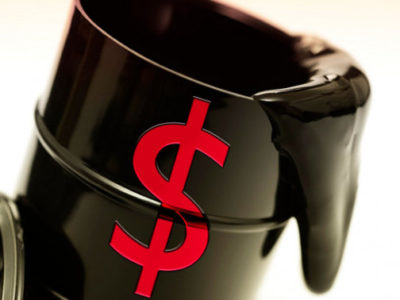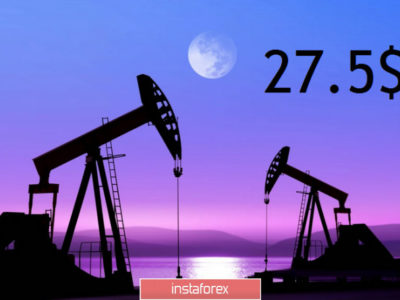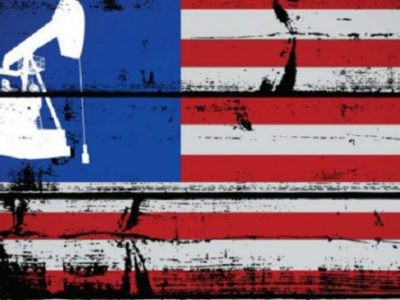WTI Oil Volatility and Options
WTI oil is the world’s most actively traded commodity and its price is highly volatile. Volatility is the amount a price fluctuates with no regard for direction. For example, if oil volatility is 10% and the current oil price is $50 per barrel, it means within the next year traders expect oil price to change by $5 up or down (either reach $55 or $45 per barrel). In reality oil fluctuates a lot more than that; in the last year it has fallen from around $100 to $50 (-50%)!
Traders may benefit from volatile oil prices by using option strategies; through buying Call and Put options you can create limited risk trades which benefit from rising volatility. The following article explains three option trades examples.
Trading an Uptrend – Buying Call Options
If you are expecting WTI OIL price to go UP and high volatility, you may consider buying a Call option which gives you the right to buy oil at a certain price (known as strike price) over a certain period of time. As the price of oil rises above the strike the option becomes more valuable. Why? Because your strike price is cheaper than the market and the more your strike can ‘beat’ the market, the more valuable the option.
When you trade an option you must chose the strike, expiry and amount. For example, the below image is a Call option trade in the easy-forex web platform, with ‘strike’ $51′, expiry’ 7-days and ‘amount’ 100 (as highlighted by the orange box). That is, an option to buy 100 barrels of oil at $51 per barrel before expiry. The total cost to buy the option is $103 (as highlighted by the blue box). If during the next week, the price of oil rises above $52.03 (strike price + cost of option at $1.03 per barrel) your option will return a profit. If the price does not rise, you may make a loss however this loss is limited to the cost of the option (premium at open), in this case that is $103.
This is a classic example of trading a rising WTI oil price in a volatile environment; you may enter a trade on a fixed risk and you do not have to worry about volatility stopping you out. As long the amount you paid for the option (‘premium at open’) is covered by expiry, you will reap the benefits of a volatile uptrend.
Trading a Downtrend – Buying Put Options
If you are expecting WTI OIL price to go DOWN and high volatility, you may consider buying a Put option which gives you the right to sell oil at a certain price (known as strike price) over a certain period of time. As the price of oil falls below the strike the option becomes more valuable. Why? Because your strike price is higher than the market and the more your strike can ‘beat’ the market, the more valuable the option.
For example, the below image is a Put option trade in the easy-forex web platform, with expiry 7-days and the right to sell 100 barrels of oil at $50 per barrel before expiry (as highlighted in the orange box). The cost to buy the option is $82 (as highlighted by the blue box). If during this time, the price of oil falls below $49.18 (strike price – cost of option at $0.82 per barrel) your option will return a profit. If the price does not fall, then you may make a loss and this loss is limited to the cost of the option (premium at open), in this case that is $82.

This is a classic example of trading a falling WTI oil price in a volatile environment; you may enter a trade on a fixed risk and you do not have to worry about volatile price swings stopping you out.
In Summary…
A Call option gives the right, but not the obligation, to BUY at a certain price over a certain period of time.
A Put option gives the right, but not the obligation, to SELL at a certain price over a certain period of time.
Premium at open is the cost to buy the option and is also your maximum risk
Trading an increase in volatility only – Buying a Straddle
If you want to trade an expected increase in volatility with no regard for direction, and benefit from a move either UP or DOWN, you may consider buying a straddle option strategy. This involves buying a Call and a Put at the same time, each option has the same strike and expiry date. If the price of oil goes UP the Call becomes more valuable and if the price of oil goes DOWN the Put becomes more valuable.
For example, the image below shows a strategy buying a Call and Put on the easy-forex web platform, both with strike $x50.70 to expire in 7-days and for an amount of 100 barrels. The total cost to buy this position is $234

$234 is your maximum risk, but what is your profit potential? You may make a profit if oil prices rise or fall, however the price must move significantly because you are trading an increase in volatility. In this example, you will be in profit as long as oil price moves above $53.04 ($50.70 strike price plus $2.34, the cost of option per barrel) or as long as the price moves below $48.36 (strike minus $2.34) by expiry.
On the Options trade zone there is a Scenarios button. This tool shows your potential profit or loss over a range of oil prices on a chart and a table. The scenarios for our example is shown in the image below. You can see a profit of 100% will be made if oil price falls to $46.02 or rises to $55.38. On the other-hand, a loss will be made if the price of oil does not move out of the range $48.36 – $53.04 by expiry. The loss is limited to $234 (the cost to enter the position i.e. ‘premium at open’).

The post WTI Oil Volatility and Options appeared first on Forex.Info.
Source:: WTI Oil Volatility and Options














